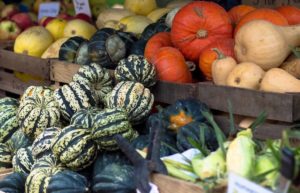Better Living for Texans: Squash the squash fear!
By Lindsey Breunig
Next time you are sitting with friends and family I challenge you to play a game of ‘who can think of the most pumpkin spice products on the market’ – I imagine you will have a very extensive list! For many, pumpkins are a sign of cooler weather, fall colors, and the holiday season approaching. Pumpkins may attract all the attention, but the gourd family includes more of these seasonal vegetables called winter squashes. Available in multiple shapes, colors, and unique characteristics, one may see them as a table decoration; however, today we are moving the decorations into our diet!
According to the USDA dietary guidelines it is recommended we consume 2 ½ – 3 Cups of vegetables daily. To maximize the benefits of vegetables we are encouraged to vary our veggies. The squash’s deep colors are a great indication of being high in vitamins, minerals, and fiber, while also being low in calories. Common varieties seen are butternut, delicata, spaghetti, kabocha (find at the Waco Downtown Farmers Market!), acorn, and sugar pumpkins.

The common characteristic and the reason I avoided cooking squash for so long is the tough skin. You can be very mean to a squash and still couldn’t ruin its day! (A little fall humor for everyone) The skin of a squash is very thick and becomes thicker as the produce matures; however, you want the firm exterior because soft skin can indicate an unripe squash or a spoiled squash. Test by knocking on the squash with your knuckle: if it sounds hollow, it is ripe! Now, there sits a squash on your counter with the only thing coming between the delicious vegetable inside is the tough outside. Below we are going to discuss ways to safely handle and overcome the squash fear.
Click to see How to Prepare Winter Squash or read below!
Start with washing the squash under running water, remove excess dirt with a vegetable brush & dry with a clean towel. A vegetable peeler works well to remove the skin from butternut squash or sugar pumpkins but microwaving first will soften the squash for easier handling.
Pierce the squash several times with a sharp knife. Place on a microwave safe plate or dish. Microwave the squash on high for 5-8 minutes (depending on use for recipe). Allow squash to cool enough for touch. Once cooled, cut off the top inch of the squash (including the stem).
For texture like mashed potatoes: Cut the squash in half. Scoop out the seeds with a spoon. Place the two halves face down on the microwave safe plate or dish with 1/2 cup of water. Microwave on high for 5 minutes. Check if the squash can be easily scooped with a spoon. If not, cook another 3-5 minutes or until the flesh is the texture of a cooked potato. Set aside to cool. Rather than boiling you can use this technique and use winter squash in these Mashed Sweet Potatoes.
For texture like roasted potatoes: *You may want to microwave less to ensure squash is not too soft* Cut squash in half. Dice the squash with a knife without cutting through the skin. Scoop out the diced pieces or scoop out the flesh and lay evenly on a baking sheet. Drizzle with oil & spices. Roast at 400 degrees until tender. Or try this recipe for Spicy Baked Squash!
Other ways to use winter squash!
Pinched on time? Check out the grocery store for precut squash. Always compare the unit price to see the best deal. See the example below, what would you choose?

Using frozen? Try this tasty recipe! Savory Bread Pudding with Kale and Butternut Squash
Enjoy!

Lindsey Breunig is a graduate of Baylor University and currently works as the Better Living for Texans Educator for the Texas A&M AgriLife Extension Service. She is originally from Grapevine, TX and now calls Waco home. Here in Waco she loves to venture out to Cameron Park, visit the local Farmers Market, and try out the awesome eateries in Waco. If you see her and hear a loud bark, that’s her pup Lucy just saying hello.
USDA is an equal opportunity provider and employer. This material was funded by USDA’s Supplemental Nutrition Assistance Program — SNAP. To learn more about the Supplemental Nutrition Assistance Program (SNAP) or to apply for benefits, visit www.yourtexasbenefits.com
The Act Locally Waco blog publishes posts with a connection to these aspirations for Waco. If you are interested in writing for the Act Locally Waco Blog, please email [email protected] for more information.
Resources: Winter Squash, Prepare Winter Squash
